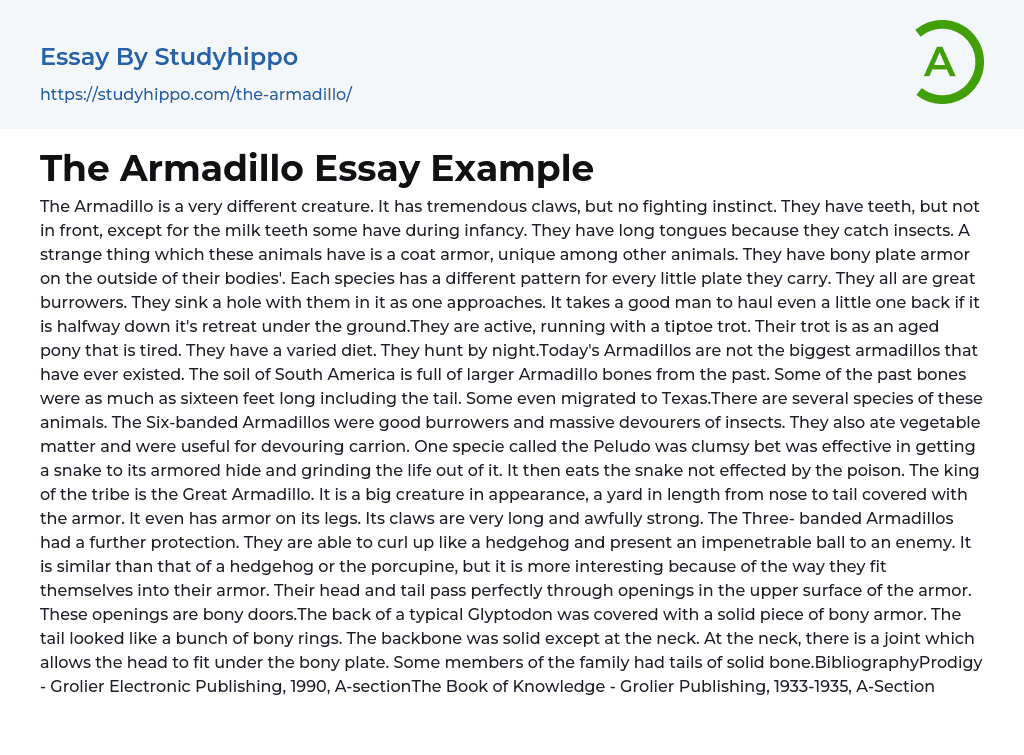The Armadillo is a unique creature known for its enormous claws and lack of fighting instinct. It possesses teeth, but only in its back during infancy when it has milk teeth. These animals have long tongues used for catching insects, but what truly sets them apart is their coat of armor. Unlike any other animal, they have a protective covering of bony plate armor on their bodies. Each species of armadillo has a distinct pattern on these plates.
Armadillos are skilled burrowers who can quickly sink into the ground to escape danger. Retrieving even a small armadillo that has gone halfway down its burrow can be quite challenging. Despite their armored protection, they move with an active tiptoe trot that resembles that of a tired aged pony.
Armadillos have diverse diets which include hunting for insects at night. However, today's armadillos may no
...t be the largest ones to ever exist. South America's soil contains larger armadillo bones from the past, some measuring up to sixteen feet in length including their tails. Some of these larger armadillos even migrated to Texas.
There are multiple species of armadillos, each with its own unique characteristics. The Six-banded Armadillos are skilled burrowers and voracious eaters of insects who also consume plant matter and scavenge carrion for food. Another species called the Peludo may be clumsy but effectively kills snakes by grinding them with its armored hide without being affected by the snake's poison before consuming itThe Great Armadillo is the dominant figure in its tribe, characterized by its large size and armored body. Measuring approximately one yard from nose to tail, this creature's entire body is covered with armor, including its legs.
Its claws are both long and incredibly strong. The Three-banded Armadillos possess an additional form of defense: they have the ability to curl up into a ball similar to a hedgehog, rendering themselves impervious to enemies. What sets them apart is how they seamlessly fit within their armor - their head and tail can effortlessly pass through openings in the upper surface of their bony armor, resembling doors. Unlike other armadillos, Glyptodons have solid bony plates covering their backs and tails consisting of bony rings. The backbone is solid except for a joint at the neck that allows the head to fit beneath the bony plate. Some species even have tails comprised entirely of solid bone.
Bibliography:
- Prodigy - Grolier Electronic Publishing, 1990, A-section
- The Book of Knowledge - Grolier Publishing, 1933-1935, A-Section
- John Locke essays
- 9/11 essays
- A Good Teacher essays
- A Healthy Diet essays
- A Modest Proposal essays
- A&P essays
- Academic Achievement essays
- Achievement essays
- Achieving goals essays
- Admission essays
- Advantages And Disadvantages Of Internet essays
- Alcoholic drinks essays
- Ammonia essays
- Analytical essays
- Ancient Olympic Games essays
- APA essays
- Arabian Peninsula essays
- Argument essays
- Argumentative essays
- Art essays
- Atlantic Ocean essays
- Auto-ethnography essays
- Autobiography essays
- Ballad essays
- Batman essays
- Binge Eating essays
- Black Power Movement essays
- Blogger essays
- Body Mass Index essays
- Book I Want a Wife essays
- Boycott essays
- Breastfeeding essays
- Bulimia Nervosa essays
- Business essays
- Business Process essays
- Canterbury essays
- Carbonate essays
- Catalina de Erauso essays
- Cause and Effect essays
- Cesar Chavez essays
- Character Analysis essays
- Chemical Compound essays
- Chemical Element essays
- Chemical Substance essays
- Cherokee essays
- Cherry essays
- Childhood Obesity essays
- Chlorine essays
- Classification essays
- Cognitive Science essays




